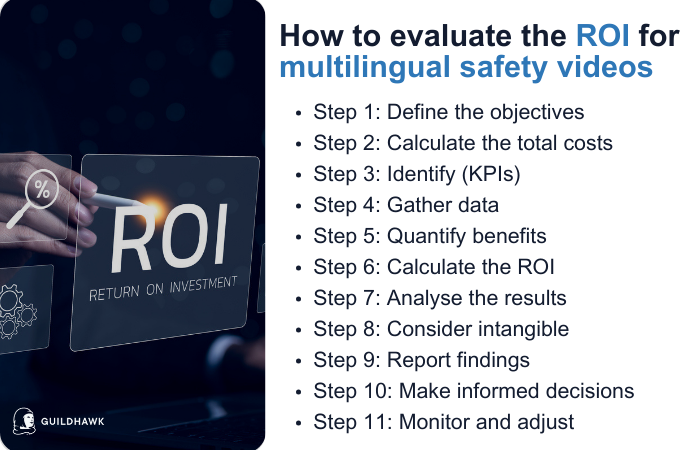
How to evaluate the ROI for multilingual safety videos
Making your safety videos available to audiences in the language they understand best is a powerful way to improve viewer engagement and increase understanding but how do you assess the value of investing into multilingual videos?
Evaluating the return on investment (ROI) for a multilingual safety video such as those created using a digital human avatar involves assessing both the tangible and intangible benefits against the costs incurred in its production and distribution.
Here is a step-by-step guide to help you through the process:
1. Define the objectives
2. Calculate the total costs
3. Identify key performance indicators (KPIs)
4. Gather data
5. Quantify benefits
6. Calculate the ROI
7. Analyse the results
8. Consider intangible benefits
9. Report findings
10. Make informed decisions
11. Monitor and adjust
Step 1: Define the objectives
Before you can evaluate the ROI, you need to define what success looks like for your safety video. Your objectives may include:
- Increasing safety compliance rates
- Reducing workplace accidents
- Promoting greater public awareness of safety issues
- Improving employee engagement with safety protocols
- Expanding safety training to non-native speakers effectively
- Introducing new ethical AI technologies to drive operational efficiency
Step 2: Calculate the total costs
To understand the investment, tally up all the costs associated with creating and distributing the multilingual video:
- Production costs (ideation, scriptwriting, design, animation, software, etc.)
- Human and AI voiceover costs for multiple languages
- Human and AI machine translation costs
- Distribution costs (data hosting, dissemination through various channels)
- Maintenance costs (updates to the video content and avatar tutors over time)
- Opportunity costs (time spent by employees producing and watching the video)

Step 3: Identify key performance indicators (KPIs)
Determine which KPIs will help you measure the effectiveness of the multilingual video.
These might include:
- Number of accidents before and after implementation
- Compliance rates with safety procedures
- Employee safety training completion rates
- Audience viewing rates by target language, role and geography
- Feedback from employees on understanding and quality of cultural adaptation
- Reduction in training and translation costs due to scalability of the video
Step 4: Gather data
Collect data related to the KPIs you've identified.
- Surveying employees for feedback
- Analysing safety incident reports
- Tracking video engagement metrics (views, completion rates, etc.)
- Comparing training costs before and after the video's implementation
Step 5: Quantify benefits
Translate the data you've collected into monetary terms where possible:
- Estimate the cost savings from a reduction in accidents and associated expenses (medical costs, downtime, insurance premiums, etc.)
- Calculate the savings from streamlining the multilingual training process (reduced translation costs, improved efficiency for trainer hours, faster onboarding, etc.)
- Consider the value of improved employee morale and retention
Step 6: Calculate the ROI
ROI is calculated by subtracting the initial cost of the investment from its final value, then dividing this new number by the cost of the investment, and finally, multiplying it by 100.
Step 7: Analyse the results
Interpret the ROI figure to determine the effectiveness of the investment:
- A positive ROI indicates that the benefits outweigh the costs.
- A high ROI suggests a highly effective investment.
- A negative ROI means the costs exceed the benefits, which may require re-evaluation of the strategy.
Step 8: Consider intangible benefits
Some benefits may not be easily quantifiable but are still valuable:
- Improved inclusivity for non-native speakers
- Enhanced company reputation for safety and innovation
- Faster introduction of safety training across international markets
Step 9: Report findings
Prepare a comprehensive report detailing the ROI and the benefits (both tangible and intangible) of your multilingual safety video. Include recommendations for future investments or improvements.
Step 10: Make informed decisions
Use the ROI analysis to make decisions about:
- Continuing investment in multilingual video productions
- Expanding the range of topics covered by such videos
- Introducing extra features such as interactive avatar tutors and tests
- Integrating videos into your Learning Management System (LMS)
- Creating a proprietary multilingual dataset to train AI video tools
- Adjusting the approach to improve ROI in future projects
Step 11: Monitor and adjust
Regularly review the performance of the safety video and update your ROI calculations as necessary. Adjust your strategy based on new data, feedback from stakeholders and advances in technology to ensure ongoing effectiveness and efficiency.
By following these steps, you can thoroughly evaluate the ROI of your multilingual safety video and make informed decisions about the use of digital human avatars in your organisation's safety training initiatives.
Learn more
To discover how Guildhawk help organisation like yours to produce multilingual videos using the latest human and AI technologies, speak to one of our team.
